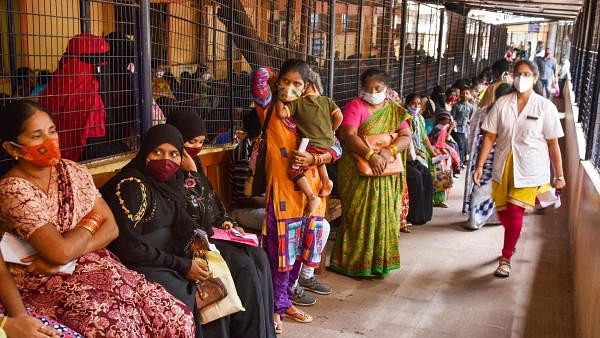
Patients wait in a long queue at a government hospital.
Credit: PTI Photo
After over a decade, on February 24, the National Sample Survey Office (NSSO) under the Ministry of Statistics and Programme Implementation (MOSPI) published the Factsheet of the Household Consumption Expenditure Survey of 2022-2023. It is anticipated that the comprehensive survey report will be released later.
This panel survey's main goal is to prepare the budget shares of various commodity categories in total consumption for studying price indices, particularly the Consumer Price Index (CPI) for rural and urban areas, by analysing the data gathered.
The survey data is often utilised to build statistical indicators pertaining to social consumption and well-being, inequality, and living standards of the population. This latest survey covering 261,746 households across all states and Union Territories was conducted from August 2022 to July 2023.
Many population-based surveys such as the Household Consumption Expenditure Survey, employ the monthly per capita consumption expenditure (MPCE), a direct indicator of living standards in poor nations, to explain differences in social outcomes based on the economic status of the population. The majority of developing nations use conventional consumption surveys conducted on a regular basis to assess the distribution of living standards, poverty, and inequality. Numerous questions about consumption are frequently gathered by these population-based consumption surveys.
The previous consumption survey was undertaken in 2011-2012. This survey coupled with the 71st and 75th rounds of the health survey (2014 and 2018) by the NSSO has given policymakers insights on healthcare expenditures of households and health indicators. Since the all-India household expenditure was released only recently, one can expect the latest health survey to be conducted and released soon.
It’s interesting to note that although the share of Out-of-Pocket Expenditure (OOPE) in the total health expenditure declined from 62.6 per cent to 47.1 per cent between 2014-2015 to 2019-2020, the Household Consumption Expenditure Survey of 2022-2023 shows a rise in medical (hospitalisation) expenses as a percentage of the MPCE from 2.15 per cent to 2.31 per cent, and also a similar rise in medical (non-hospitalisation expenses) from 4.5 per cent to 4.66 per cent as a percentage of the MPCE in rural India between 2011-2012 and 2022-2023. In urban India, the survey shows a decline in medical (hospitalisation) expenses as a percentage of the MPCE from 1.96 per cent to 1.89 per cent, but a rise in medical (non-hospitalisation expenses) from 3.58 per cent to 3.96 per cent as a percentage of the MPCE in the same time period.
In general, people in rural India spent more on medical expenses (6.96 per cent share of the total MPCE) compared to those living in the urban areas (5.85 per cent share of the total MPCE) in 2022-2023. When the survey is undertaken, the medical (hospitalisation) expenses are calculated for a household during the last one-year time period. These include medicine; doctor's/surgeon's fees; hospital & nursing home charges; X-ray, ECG, pathological tests, etc. and other medical expenses.
The medical (non-hospitalisation expenses) are calculated for a household during the last 30 days’ time period. These include medicine; doctor's/surgeon's fee; X-ray, ECG, pathological test, etc.; family planning devices and other medical expenses.
While analysing health spending by households, the survey also looks at expenditure for purchase (including repair and maintenance) of medical equipment for domestic use during the last 365 days, and the extent of utilisation of the Pradhan Mantri Jan Aarogya Yojana (Ayushman Bharat) or any other state-specific public health scheme by households between 2022-2023. More disaggregated data is needed to analyse questions like how the recent health policies shaped peoples’ healthcare choices, especially post-Covid-19.
The MOSPI factsheet is a welcome move as it’s expected to help policymakers understand the health expenditure of Indian households in recent times in the rural and urban areas of the nation.
(Sukanya Das is Professor, Department of Policy and Management Studies, and Dean (Research & Partnerships), Teri School of Advanced Studies, New Delhi.
Megha Jacob is Assistant Professor, Department of Economics, Jesus and Mary College, University of Delhi)
Disclaimer: The views expressed above are the author's own. They do not necessarily reflect the views of DH.